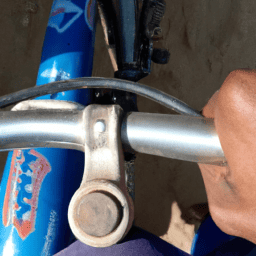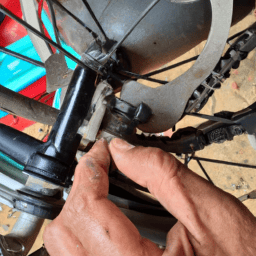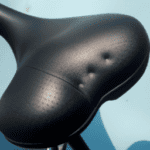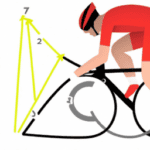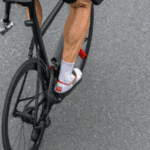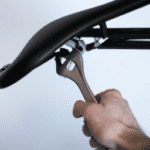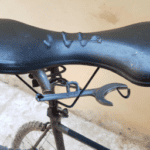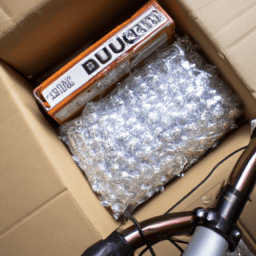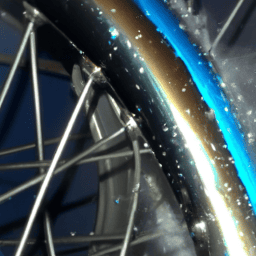As someone who often rides a bike, I’ve dealt with my own struggles regarding the discomfort of my bike seat. This kind of pain isn’t rare among cyclists, particularly for those who are recent enthusiasts or haven’t yet discovered the perfect saddle that suits their body type and cycling manner.
But why does it happen?
In this article, I’ll explore the reasons why your bicycle seat might be causing you discomfort and offer some solutions to help alleviate the pain. From understanding your body and riding style to adjusting your saddle position and wearing proper cycling shorts, there are a variety of factors that can impact your comfort on the bike.
So, let’s dive in and find some solutions to make your next ride more enjoyable.
Key Takeaways
- Discomfort with bicycle seats can be caused by improper bike fit, incorrect body posture, and wrong saddle selection.
- Solutions to discomfort include professional bike fitting, choosing the right saddle based on materials and sit bone measurement, padding in cycling shorts and on the seat, and experimenting with different seats and bike fit.
- Factors that affect saddle comfort include saddle materials, saddle width and sit bone measurement, and saddle position and tilt.
- Other tips for reducing discomfort include proper maintenance of shorts and padding, relaxed hand placement on handlebars, and proper cycling attire, while potential causes of discomfort include hunching or leaning too far forward, slouching, and stomping on pedals. Finding the perfect fit may take trial and error.
Understand Your Body and Riding Style
You’ll need to take some time to understand how your body interacts with your bike and how your riding style may be affecting your discomfort. One of the most important factors to consider is bike fit. If your bike isn’t properly adjusted to your body, it can cause pain and discomfort in various areas, including your seat.
Make sure your bike is the right size for you and that the saddle height, angle, and position are all adjusted correctly. A professional bike fitting can help ensure that your bike is set up properly for your body.
Another important factor to consider is your body posture while riding. If you’re hunched over or leaning too far forward, it can put extra pressure on your seat and cause discomfort. Make sure you’re sitting up straight with your shoulders relaxed and your weight evenly distributed between your hands and feet. This will help take some of the pressure off your seat and distribute it more evenly throughout your body.
By understanding how your body interacts with your bike and adjusting your bike fit and posture accordingly, you can help alleviate some of the discomfort you may be experiencing in your seat.
Now, let’s move on to choosing the right saddle.
Choose the Right Saddle
To find relief from discomfort while riding, it’s important to select a saddle that properly fits your body and riding style. Saddle materials play a significant role in determining comfort levels.
Saddles made of leather or synthetic materials provide more durability and support than those made of foam or gel. However, foam or gel saddles are softer and more cushioned, making them ideal for short rides or for people who are just starting out.
When it comes to choosing the right width, it’s essential to measure the distance between your sit bones accurately. Sit bones are the bony protrusions at the bottom of your pelvis. By measuring the distance between them, you can determine the right saddle width that aligns with your bone structure.
A saddle that is too narrow will put pressure on your soft tissue, causing discomfort. Conversely, a saddle that is too wide will cause chafing on your thighs. Choosing the right width ensures that your weight is evenly distributed on the saddle, providing maximum comfort during your rides.
To ensure a comfortable ride, adjusting your saddle position is the next step.
Adjust Your Saddle Position
Feeling like Goldilocks trying to find the perfect fit, adjusting your saddle position will make all the difference in your riding comfort.
To ensure proper saddle height, stand next to your bike with your shoes on and place your heel on the pedal at its lowest point. Your leg should be fully extended, with a slight bend in your knee. This will help prevent knee pain and injury.
Tilting the saddle is also important. A level saddle may not be comfortable for everyone, as it can put pressure on sensitive areas. Experiment with tilting the saddle slightly up or down until you find a position that feels comfortable.
Remember, small adjustments can make a big difference. By taking the time to properly adjust your saddle position, you can avoid unnecessary discomfort and enjoy a more pleasant ride. And don’t forget to wear proper cycling shorts for added comfort.
Wear Proper Cycling Shorts
When it comes to cycling, one of the most important things to consider is your attire. Specifically, you need to make sure you’re wearing proper cycling shorts. This is crucial in avoiding discomfort or even pain during long rides.
Two key factors to consider when choosing cycling shorts are the amount of padding and finding the right fit. As someone who’s experienced the discomfort of poorly fitting shorts, I can attest to the importance of these factors in ensuring a comfortable and enjoyable ride.
Importance of Padding
Padding can make a significant difference in how comfortable your bike seat feels during a ride. When choosing materials for your bike shorts, it’s important to consider the type and amount of padding they offer. Look for shorts with a chamois that provides adequate cushioning for your sit bones, as well as ventilation to prevent moisture buildup.
Proper maintenance of your shorts is also key to ensuring the padding remains effective over time. Avoid using fabric softener when washing your shorts, as it can break down the materials and reduce the effectiveness of the padding.
In addition to padding in your shorts, it’s important to consider the padding in your actual bike seat. Most bike seats come with some level of padding, but if you find that it’s not enough, there are plenty of options for adding extra cushioning.
Gel seat covers or padded seat cushions can be added to your existing seat to provide more comfort. However, it’s important to make sure that any additional padding doesn’t interfere with your riding position or cause any chafing.
Finding the right fit for both your shorts and seat is crucial for a comfortable ride.
Finding the Right Fit
As I prepare for my next ride, I know that finding the right fit for my bike shorts and seat is crucial in ensuring my comfort and performance on the road. Here are some tips to help you find the perfect fit for your bike seat:
-
Seat height: Adjusting your seat height is essential to ensure your knees are in the right position for optimal pedaling. A good rule of thumb is to have your leg almost fully extended when the pedal is at its lowest point.
-
Saddle angle: The angle of your saddle can make all the difference in your comfort level. Make sure it’s level or slightly angled downward to prevent unnecessary pressure on your sit bones.
-
Seat width: Choosing the right size seat can also make a big difference. A seat that’s too narrow can put pressure on sensitive areas, while a seat that’s too wide can cause chafing.
-
Experiment: Don’t be afraid to try different seats and adjust your bike fit until you find what works best for you. It may take some trial and error, but it’s worth it for a comfortable ride.
By following these tips, you’ll be well on your way to a comfortable bike ride.
But finding the right fit is just one piece of the puzzle. It’s also important to practice proper cycling techniques to avoid unnecessary discomfort and injury.
Practice Proper Cycling Techniques
To avoid a sore bum on your bike ride, make sure you’re practicing good cycling techniques. Keep your back straight and engage your core muscles. Proper posture is essential in preventing discomfort from prolonged sitting on your saddle.
Ensure that your back is straight and your shoulders are relaxed. Avoid slouching as it can cause additional pressure on your lower back and lead to discomfort.
Another important technique is to focus on your pedal stroke. Make sure you’re pedaling smoothly and efficiently. Avoid stomping on the pedals as it can cause unnecessary pressure on your saddle. Also, practice breathing techniques to help you relax and maintain a steady rhythm.
Lastly, pay attention to your hand placement on the handlebars. Keep your hands relaxed and avoid putting too much pressure on them. By practicing these cycling techniques, you can reduce the chances of experiencing discomfort on your bike ride and enjoy a more pleasant cycling experience.
Frequently Asked Questions
How often should I replace my bike saddle?
I replace my bike saddle every 3-5 years or when it shows signs of wear and tear. Proper saddle maintenance, such as keeping it dry and clean, can prolong its lifespan. Choosing the right saddle is also crucial for comfort.
Can I use a gel seat cover to reduce discomfort?
Yes, gel seat covers can provide temporary relief for discomfort, but proper bike saddle positioning is crucial for long-term comfort. They can be effective when used with a properly positioned saddle.
Are there any specific stretches I can do to alleviate saddle soreness?
To alleviate saddle soreness, I recommend incorporating yoga poses and massage techniques into your routine. Additionally, ensuring proper bike fit and posture can prevent discomfort. Focus on stretches that target the hips, hamstrings, and lower back to reduce pressure on the seat.
Can a poorly fitting bike frame contribute to saddle discomfort?
A poorly fitting bike frame can contribute to saddle discomfort because it affects the saddle pressure distribution. Adjusting the saddle height and angle can help, but getting a proper bike fit is the best solution.
Are there any non-surgical treatments for persistent saddle soreness?
I’ve found that bike fit and wearing padded shorts are effective non-surgical treatments for persistent saddle soreness. Proper bike fit helps distribute pressure while padded shorts provide additional cushioning, reducing discomfort and preventing future soreness.
Conclusion
In conclusion, understanding the root cause of your bicycle seat discomfort is crucial in finding a solution that works for you. It starts with understanding your body and riding style.
Whether you’re a casual rider or a competitive cyclist, taking the time to choose the right saddle and adjusting its position can make all the difference. Additionally, wearing proper cycling shorts and practicing proper cycling techniques can also help reduce the discomfort of a bike seat.
Remember, Rome wasn’t built in a day, so give yourself time to adjust to your new setup. As the saying goes, "practice makes perfect."So keep pedaling and soon enough, you’ll be able to ride comfortably for miles on end.
